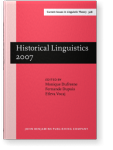Wild variation, random patterns, and uncertain data*
The sequencing between an infinitive and clitics in pre-modern Spanish changed from the absence of any principle in Latin to variable proclisis (13th century), prevalent proclisis (15th century), and finally categorical enclisis as a complete trend reversal (17th century). The strong increase in proclisis up to the 15th century is driven by dominant models in the language (with preceding negation, preposition, etc., following the sequencing with finite verb forms). Since standard analyses are not adequate here, an analysis relying on analogy will be compared with an interpretation based on the unreliability of documentation. This second approach leads to an explanatory impasse. While analogical modeling of unruly data implies a diminished role for strict regularity, it provides a much better fit with the data than standard rules, or a blunt challenge to the data, making it the preferred solution by far.
